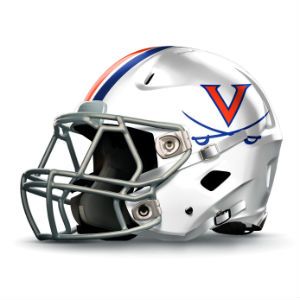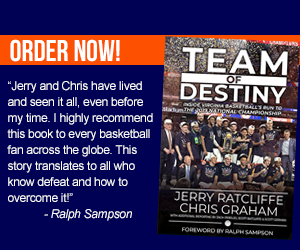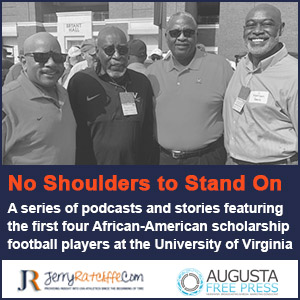Looking Back at Notre Dame
With all the film study, scouting and analysis that football coaches pore over each week as they prepare for the next opponent, they usually have a pretty good handle on what to expect on the weekend.
This is nothing new. I remember back in 1984, when Virginia was on a six-game unbeaten streak and was set to face 12th-ranked West Virginia in Morgantown. Mountaineer fans were convinced they were going to a major bowl and had an offense that would be hard to stop.
Yours truly was scheduled to appear on “Sunrise Breakfast with the Mountaineers” pre-game show with the late Tom Mees, the West Virginia play-by-play guy, who was also one of the original cast of ESPN television. It appeared on paper that WVU was a slight favorite, but that UVA definitely had a chance.
That was my thinking until I ran into some of the Virginia coaches in the hotel bar that night. Talking to them confidentially, they said that they were going to kick West Virginia’s ass. I was a little surprised by their confidence, but convinced that they knew what they were talking about.
The next morning, in the hotel’s dining room, where the show was broadcast live and over the dining room’s speakers, I didn’t win any friends when Mees asked me about my opinions concerning the game coming up that afternoon. I told him that I thought Virginia would win and that it might not be close, then explained why.
Guess I spoiled a lot of Mountaineer breakfasts that morning from the looks and comments I was receiving. Nevertheless, I was confident in what the coaches passed on to me.
Virginia indeed kicked WVU’s butts all over the field that afternoon, winning a lopsided 27-7 contest.
Coaches most always have a good handle on what’s coming, and so that was one thing that really stuck out to me in Bronco Mendenhall’s press conference after losing 35-20 at Notre Dame last weekend. The Cavaliers led 17-10 at the half, but five turnovers and eight sacks killed them over the course of the game, particularly in the second half when they kept giving the Irish short fields.
Yeah, I know, I know. What Bronco said about the lack of establishing a running game and the offensive line’s inability to block Notre Dame was clearly major. It was nothing that we didn’t see coming.
Anyone who really knows Virginia football, has seen the struggles in the running game all season, and has known that the offensive line has had major problems.
Bronco pointed out that two of the turnovers, one resulting in an Irish TD, and the other leading to one, were basically the difference in the game. While eliminating those didn’t guarantee a UVA win, eliminating those would have essentially meant that Mendenhall and his staff had the game pegged.
“That was the kind of game we were anticipating, to where it was a field goal at the end,” Bronco said.
To me, that statement spoke volumes. While Notre Dame was No. 10 nationally and about a two -touchdown favorite by the boys in Vegas, Bronco’s analysis was essentially spot on.
He and his staff knew they could play with the Irish, even realizing his team’s shortcomings in the running game and pass protection. With all that considered, had things gone as planned, it would likely have come down to a field goal by one of the two teams.
That’s why he believed Virginia had to “steal a possession” somewhere along the way. That’s why the UVA coaching staff noticed a weakness in Notre Dame’s kickoff return team by scouting the Irish on film, and schemed an onside kick that the Cavaliers practiced all week leading up to their trip to South Bend.
Virginia was successful in that onside kick in practice and was confident they could pull it off against the Irish. Bronco was waiting for the right time and decided to wait until the second half, when they stunned the 77,622 in Notre Dame Stadium by opening up the half with the onside kick and recovered.
Problem was, they couldn’t convert the stolen possession into points and had to punt. Two of the problems on that UVA possession was a sack for minus-seven yards that led to a third-and-13, followed by a false start on Chris Glaser, that made in third-and-18, then eventually a punt.
Now, in the midst of a bye week, with two weeks to prepare for Miami, in what could be a huge factor in deciding the ACC Coastal Division, Mendenhall and his staff must figure out how to advance the running game. Before, they were able to semi-disguise the lack of a good running attack and that they were vulnerable to pass rush, leaving Bryce Perkins vulnerable as well.
Wahoo fans suspect that Perkins isn’t quite as healthy as he claims. He tweaked a knee in training camp, has worn a brace since, and doesn’t appear quite as fast when he takes off on a run.
Plus, why take a chance on getting your quarterback, your golden egg, injured in a nonconference game when so much more lies ahead.
How does a team, now that its warts have been exposed, correct the problem in two weeks? Do they decide to keep more protection in the backfield and send out fewer receivers? Do they add screen passes to slow down opposing pass rushes?
One of the things George Welsh used to do was, quoting Olivia Newton-John, “get physical.”
Welsh would practice the running game ad nauseum. Over and over and over until it was done right, until the offensive line or running backs or both, toughened up to the point where they could be effective.
Everyone on the team knows the running game has to become legit if Virginia is going to win the Coastal as predicted. One-dimensional teams go nowhere.
It all starts up front. The offensive line must respond or this team will be nothing but mediocre.
Check out this statistic.
The rate of pressures allowed vs. FBS competition so far this season, Virginia ranks No. 108 out of 130 FBS teams. That stinks and has to change.
“It was on us,” said UVA center Olusegun Oluwatimi. “We were losing our one-on-one matchups, not giving Bryce (Perkins) time. The pocket was getting pushed. We definitely got to fix things up front and get better because it’s putting our team at risk.”
Oluwatimi nailed it.
Too many hits like that on Perkins and things could get ugly in a hurry. Bronco has not shied away from the fact for the past season and a half that this team will go only as far as Perkins can take it. A healthy Perkins, who is protected, could take UVA a long way. A banged up Perkins is quite different.
Perkins can fling the rock. He showed that against a good Irish defense. Well, at least when he had time. And, yes, sometimes he held onto the ball too long, but still, when he has time, he’s usually accurate.
Hasise Dubois, who was spectacular at times, hauling in nine passes, said it best.
“After this performance, with me and Joe (Reed, also nine catches), teams are going to try to double team us, so the running game will help open things up,” Dubois said.
Play-action only works if the defense believes there’s a true running threat.
Al Groh told me something once that he learned in the NFL about the running game.
“All running backs run the same when there’s no hole,” Groh said.
No truer words were ever spoken.
It all starts up front. That’s Virginia’s assignment for the rest of this week and the first part of next week: Find a way to open holes and find a way to protect the quarterback.









